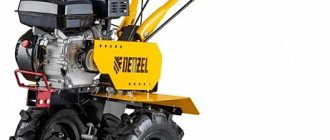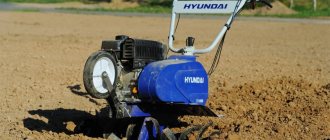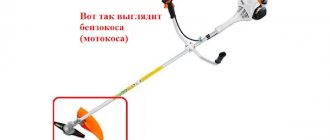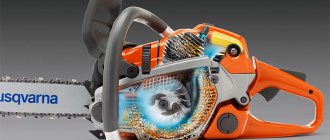A modern summer resident often faces a problem: how to quickly and efficiently cultivate a plot of land. We recommend choosing a walk-behind tractor or cultivator for this. They are ideal for a large vegetable garden, and the set of attachments makes them indispensable on the farm.
- Why is it necessary to till the soil?
- What is the difference between cultivation and plowing
- What types of walk-behind tractors are there?
- What engines and fuel are used in walk-behind tractors?
- Important technical parameters of walk-behind tractors
- What types of cultivators are there?
- What engines and fuel are used in cultivators
- Important technical parameters of cultivators
- What additional attachments are used?
Why is it necessary to till the soil?
There are several reasons to plow and cultivate the land:
Salinity and lack of oxygen
The upper layer of the earth dries out, and in the deeper layers moisture is retained and salt is deposited. Productivity depends on this. If the top layer is loosened and turned over, the soil receives oxygen. It is necessary for important microorganisms.
Weeds and pests
After plowing, the weed roots die in the sun or die from damage.
Soil erosion or excessive compaction
Wind erosion blows away the fertile part of the land. Soil compaction compresses the pores that should conduct water and air. This prevents root growth.
Previously, summer residents used a shovel or horses for such excavation work. Hand cultivators cope well with tasks in oversized summer cottages with well-groomed soil, small flower beds and beds. On hard ground it is difficult to use hand tools. Not everyone can physically work like this. Therefore, in modern dachas, large gardens and vegetable gardens, walk-behind tractors, cultivators and mini-tractors are used.
Mechanization of manual labor provides many advantages, including saving time, effort and efficient performance of such work as:
- plowing the land;
- cultivation;
- preparing furrows for planting;
- hilling;
- digging up root crops.
What to choose
How to choose what to buy? What is better, walk-behind tractors and walk-behind cultivators? Depends on the size of the area that you plan to cultivate, the list of works that you want to automate, and the soils on the site.
What to choose? Walk-behind tractor or cultivator
Where and for what is it better to use motor cultivators
For a dacha, garden, or vegetable garden with an area of up to 10-15 acres, a motorized cultivator is quite sufficient. Especially if the soils are light. This device does a good job of loosening the soil and cultivating row spacing, but it usually works at one speed. Only some, more expensive models can have two speeds; even less common is the ability to change the direction of movement (reverse).
The main equipment is cutters. They come in different sizes for different row spacings. Replacing a cutter takes little time, which is convenient. Only the heaviest and most powerful (read: expensive) models can cope with plowing, and even then, on light and medium soils. Moreover, we are not talking about deep processing.
Small motor cultivators are the best choice for processing small areas
Some owners adapt hillers to more powerful models. The quality of processing is not always high. It is normal only on light soils. Even with preliminary loosening, the row spacing has to be adjusted manually. Although the work is certainly much easier.
The wheel, most often, is one - central, solid. That is, during operation, some effort will be required to keep the tool in a stable position. In general, for a standard summer cottage, a motor cultivator is an excellent choice. Larger areas require more powerful equipment.
Scope of application of walk-behind tractors
If the area of the cultivated area exceeds 20 acres, it makes sense to buy a walk-behind tractor. Unlike motorized cultivators, they have several transmission speeds and the ability to reverse. There are usually few speeds, 2-3 when moving forward and 1-2 when moving backward.
Walk-behind tractors are needed for large areas
The number of attachments for walk-behind tractors is greater: in addition to cutters, you can install a plow, mower, and hiller. Due to the greater power, soil cultivation proceeds faster and greater depth is possible. The depth changes due to the installation of weights that lower the cutter or plow lower.
Walk-behind tractors have two pneumatic wheels, making them more stable. The effort required when working is minimal; you just have to control the direction.
What is the difference between cultivation and plowing
If, during plowing of a plot, the earth is turned over in layers, then in the case of cultivation, it is loosened to a certain depth, thereby the fertile layer of soil remains in place.
As the cultivator passes, the top layer of soil loosens and crumbles, resulting in mixing of the soil. Afterwards the area is leveled and visually enlarged. During cultivation, the roots of harmful plants and weeds are also pruned. This is especially necessary after winter, when the pressure of snow and moisture causes the soil to become compacted.
The importance of arable work in the country is complemented by labor intensity. This is physically difficult work, so choosing the right assistant device can greatly facilitate tasks on the land. Thus, 10 acres of land can be cultivated not in 2 days, as by hand, but in 2-3 hours. So what should you buy: a walk-behind tractor or a cultivator?
Popular models of cultivators and walk-behind tractors
There are a lot of similar equipment sold in stores. To know which models are the most popular today, let’s take a look at some of them. Lightweight walk-behind tractors are equipped with an engine power of up to 5 hp. With. This technique is not suitable for working with a plow. It is designed to work in a small area. A middle class car is heavier and more powerful. Its cost is higher. A heavy walk-behind tractor weighs up to 200 kg. A seat is attached to it. Heavy machines include Profi PR 1040E. This mini tractor has a 600 cm³ engine. Its power is 10 hp. With.
The large weight (300 kg), size and cost (over 100 thousand rubles) do not add to the popularity of the unit. Our gardeners most often purchase other equipment, including:
- Neva MB-1B-6, OFS. Consumers have been using this unit for a long time. He doesn't have any transmission problems. Spare parts are sold in stores. Replacing them is not difficult. The engine runs on gasoline and has a power of 6 liters. With. The price of the product is about 46 thousand. Reviews from owners indicate that after 300 hours of hard work the power does not drop. The machine is maneuverable, works both in the garden and for transporting goods. The model is equipped with headlights and a three-speed transmission.
- Agate KhMD-6.5, weight - 85 kg. The diesel engine develops a power of 6.5 liters. With. Gear shifting is done from the handle. Advantages of the model: good traction, low gear. Disadvantages: manual start, few functions performed. Cost - 30 thousand.
- Belarus 09N-01. The device is widely used among gardeners. Production started in 1991. Many years of operating experience allowed us to get rid of all the shortcomings. The gasoline engine is equipped with a transmission with two rear and four forward gears. There is a locking differential and a power take-off shaft. The machine is reliable, powerful, with good efficiency and high quality assembly. It costs about 80 thousand.
You can purchase additional attachments for walk-behind tractors to perform various jobs: plows, cutters, hillers, potato planters, seeders, waste shredders, trailers, mowers, tedders and other devices.
What engines and fuel are used in walk-behind tractors?
Walk-behind tractors are equipped with both gasoline and diesel engines.
Diesel engines are found infrequently, mainly on medium and heavy (professional) devices. They have a four-stroke configuration, are simple and reliable in operation.
Gasoline engines are high-power and efficient. Gasoline walk-behind tractors can be two- or four-stroke. The two-stroke is fueled with a mixture of gasoline and oil, and the four-stroke is fueled with pure fuel. An engine running on pure gasoline is less noisy and does not require much fuel.
Gasoline walk-behind tractors are lighter than diesel ones, making it easier to maneuver when working with soil. Diesel fuel is cheaper due to low consumption, but such walk-behind tractors are more expensive.
Walk-behind tractors use tanks with a capacity of 3.6 or 6 liters, but there are also larger devices with tanks of 8.5 and 10 liters. When choosing, rely on the amount of work to be done and compare it with fuel consumption. The approximate consumption of this garden equipment is 1 liter per hour.
Main differences
Equipment for performing agricultural work must be selected with great care and attention. Mechanical and electrical units for cultivating land are expensive. Not every gardener is ready to shell out money for something that turns out to be unnecessary to him. For this reason, it is worth knowing well the difference between a walk-behind tractor and a cultivator.
Externally, both units are similar to each other. They are intended for pre-sowing and harvesting tillage. But they have big differences. A motor cultivator loosens the ground. This operation is needed before planting the future crop. The walk-behind tractor does the same work, but can also clear the area of snow in winter, transport various loads, and split firewood. This is the main difference between a walk-behind tractor and a walk-behind cultivator.
The motor cultivator can be produced with a gasoline or electric engine. It provides many conveniences when processing small areas. The walk-behind tractor is equipped only with a gasoline or diesel engine. It moves on its own wheels with lugs. Among motor cultivators, only powerful units are capable of this. This is another difference that cultivators and walk-behind tractors have.
How else does a walk-behind tractor differ from a cultivator? Let’s consider the main criteria:
- The engine power of a walk-behind cultivator is less than that of a walk-behind tractor. Gasoline cultivators are equipped with engines with a power of 1-6 hp, electric cultivators - up to 2.5 kW, and manufacturers install engines with a power of 6-13 hp on gasoline and diesel walk-behind tractors. The capabilities of walk-behind tractors allow you to cultivate hard ground on surfaces with the possible overturning of other machines. In addition, if the machine is faced with a difficult task - plowing virgin soil, even the most powerful motor cultivator will not cope with it.
- Motoblocks are much heavier. Their weight varies from 70 to 300 kg, while the weight of cultivators ranges from 15 to 80 kg. The weight of heavy units creates good traction with the soil.
- Walk-behind tractors win in terms of performance according to the main operating parameters:
- the cultivator's processing area is from 1 to 20 acres, while heavy-duty walk-behind tractors cope with areas of up to 3 hectares;
- the processing width of electric and motor-cultivators varies in the range of 15-90 cm, and for some walk-behind tractors this figure can reach 130 cm;
- The operating speed of walk-behind tractors is higher by default, since they are self-propelled, equipped with large wheels and a gearbox with up to 8 gears.
The walk-behind tractor is a good assistant for the farmer. He performs the main work, which is difficult. These include:
- plowing the soil;
- cultivation;
- harrowing the site;
- hilling of crops;
- cutting furrows;
- planting crops;
- harvest.
The walk-behind tractor can work on areas of 3-4 hectares. This helps to preserve your health. What is the difference between the units is now clear.
Important technical parameters of cultivators
Gearbox type
The gearbox rotates the main mechanism in the cultivator. Two types of gearboxes are used in motor cultivators: chain or worm. The chain mechanism is used in heavier models. It has a long service life, the ability to reverse and is superior in quality to worm gear.
Models with a worm gear are not suitable for previously unplowed soil.
Cultivation depth and width
The distance to which the cultivator cutters penetrate the soil is important. The depth can be changed by adjusting the coulter - a metal strip that is vertically attached to the rear of the cultivator. The average cultivation depth is usually no more than 25 cm.
The working width is adjusted by installing various cutters. For most cultivator models, they are made in the form of a connection of several easily removable segments. The optimal working width for small areas is 40-70 cm.
What to look for when choosing...
...cultivator
The equipment can be powered by electricity or gasoline. For small areas, lightweight electric cultivators are usually used; they are easy to operate and do not require special care. The situation is more complicated with gasoline units; before starting work, you need to check the oil level. A two-stroke cultivator uses more gasoline than a four-stroke one. And this technique is very noisy.
When choosing a cultivator, pay attention to the following points:
- If your site consists of hills, then inquire about the possible angle of inclination. Because there are models that work on any slope, and there are those that work at an angle of no more than 20 degrees.
- If you choose medium or heavy equipment, then make sure that it has a reverse gear.
- It’s good if the cultivator has several speeds, so it can be used for different purposes.
- For safety, it is better to opt for cultivators with a special lever, rather than a push-button one, since for emergency braking you will only need to pull the lever towards you.
- Similar models may have completely different basic equipment, so before purchasing, carefully study the instructions, which tell you what is included in the kit.
- The grip width is determined by the width of the cutters, so if your area is not level, then you need to immediately buy a set of cutters. In addition, you also need to consider what kind of soil.
- If you need a powerful unit, then give your choice to heavy cultivators.
... walk-behind tractor
If you decide to purchase a walk-behind tractor, you need to understand its main characteristics:
- Power. The larger the area of the treated area, the higher the power of the unit should be.
- Fuel. Walk-behind tractors use both gasoline engines, which operate more quietly and can be started even in winter, and diesel engines, which have lower fuel consumption. If a gasoline walk-behind tractor can help you in small areas with good soil, then for a larger area it is better to immediately take a diesel one.
- Weight. The less weight, the easier the grip. Wheel weights are also sold, but without a starting light weight they are ineffective.
- Working width. The greater the width of the cutter, the larger the area processed. The cutter must be dismantled. In this case, you can remove part of it and walk between the rows with a walk-behind tractor. But here you need to take into account that the wider the cutter, the less the soil is processed in depth and the greater the load on the shoulders and back.
- PTO. It is found in all walk-behind tractors and is needed for aggregating attachments.
- Price. The price of a walk-behind tractor depends on the manufacturer; reputable brands are more expensive than products from Chinese companies.
How is a walk-behind tractor different from a cultivator?
The main difference between these two units is their functionality, which, in turn, is related to the design of this equipment.
Cultivators are more limited in their capabilities. Their main functions are cultivation, loosening, improving the soil structure, and leveling it. Most often they are very light (sometimes the weight of some models does not even reach 15 kilograms). They do not have a gearbox, and engine power varies from 3 to 6 horsepower.
Often, instead of wheels, cutters come as standard. They have limited capabilities for using attachments. There are gasoline, diesel, battery and even powered ones. Based on these possibilities, it is advisable to use them only during the active period of the year for farming (from spring to autumn).
The difference between a cultivator and a walk-behind tractor is that a walk-behind tractor has many more capabilities. They can be used not only for a variety of work in the garden (plowing, hilling, loosening, digging up root crops, etc.), but together with the appropriate attachments they become indispensable assistants in the garden. With their help, you can transport cargo, mow grass, pump water, remove snow, dig trenches and even chop wood.
Based on their capabilities, walk-behind tractors also have appropriate technical characteristics. They are much heavier, they have a powerful engine with a gearbox, and they often have headlights. In general, walk-behind tractors are distinguished by their power, versatility and the ability to use this equipment all year round.
What is better - a walk-behind tractor or a walk-behind cultivator?
We looked at the difference between a walk-behind tractor and a walk-behind cultivator. A logical question arises - which of the two units is better? Let's summarize the main advantages and disadvantages of both.
Pros of a motor cultivator:
- it has a simple design, is very easy to operate and is easy to disassemble;
- transportability (even when assembled, it can easily be transported in the trunk of a car);
- the ability to work in confined spaces and hard-to-reach places (between trees, in flower beds, near buildings). And cultivators with electric motors still have the ability to work in a closed, confined space (for example, in a greenhouse) due to the absence of exhaust;
- low cost.
Based on what was said in the previous subsection, this type of technology has one drawback - limited functionality and small capabilities.
Pros of the walk-behind tractor:
- high engine power;
- multifunctionality and versatility;
- Possibility of use all year round;
- capable of processing virtually any type of soil.
Among the noticeable disadvantages are high cost, difficulties in operation and repair, large dimensions, which is not always convenient for transportation and storage.
In general, when deciding on the choice of equipment for your site, take into account the range of upcoming work. If, apart from the planned periodic cultivation of a small plot of land, no work is expected, feel free to buy a motor cultivator. If you have a fairly large plot of land, a farm, and there are many tasks that are difficult to do with your own hands, it is better to spend money once and purchase a reliable walk-behind tractor of appropriate power and attachments for it.











